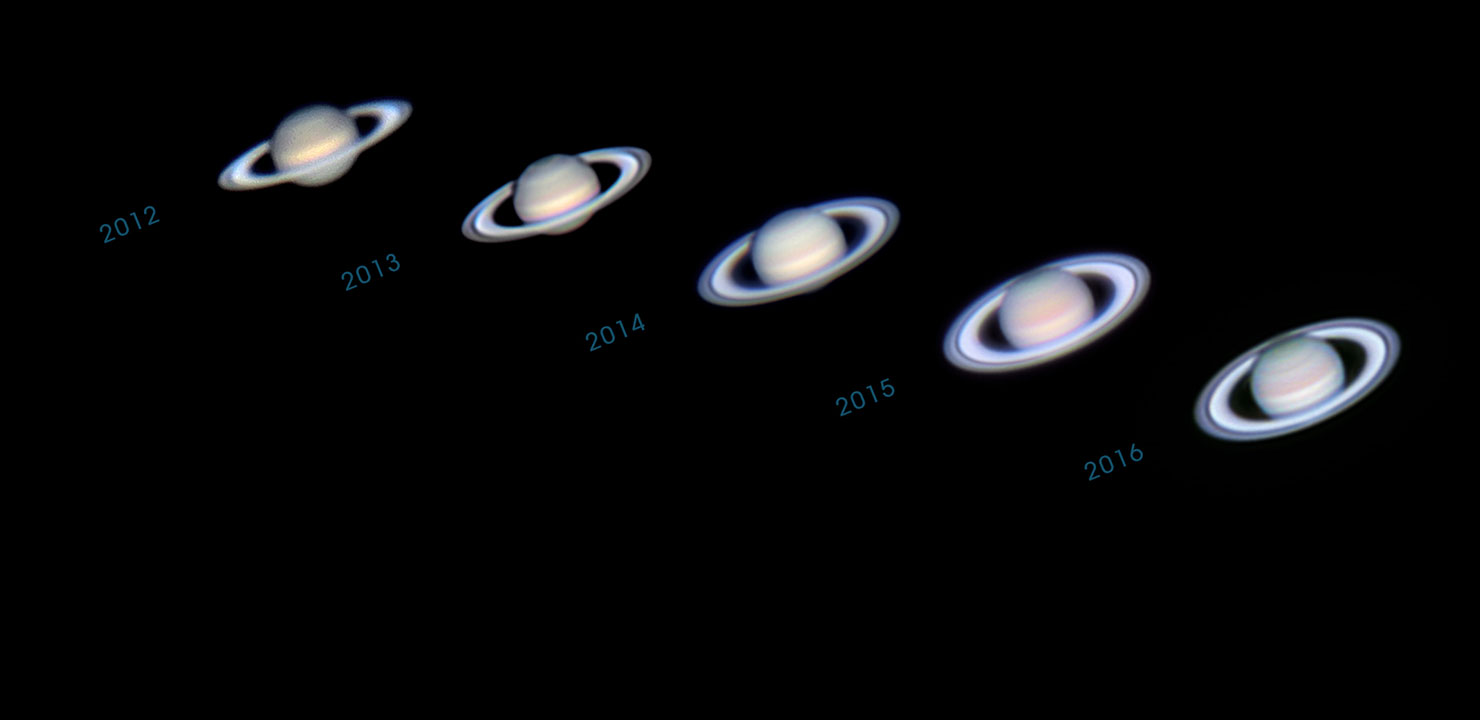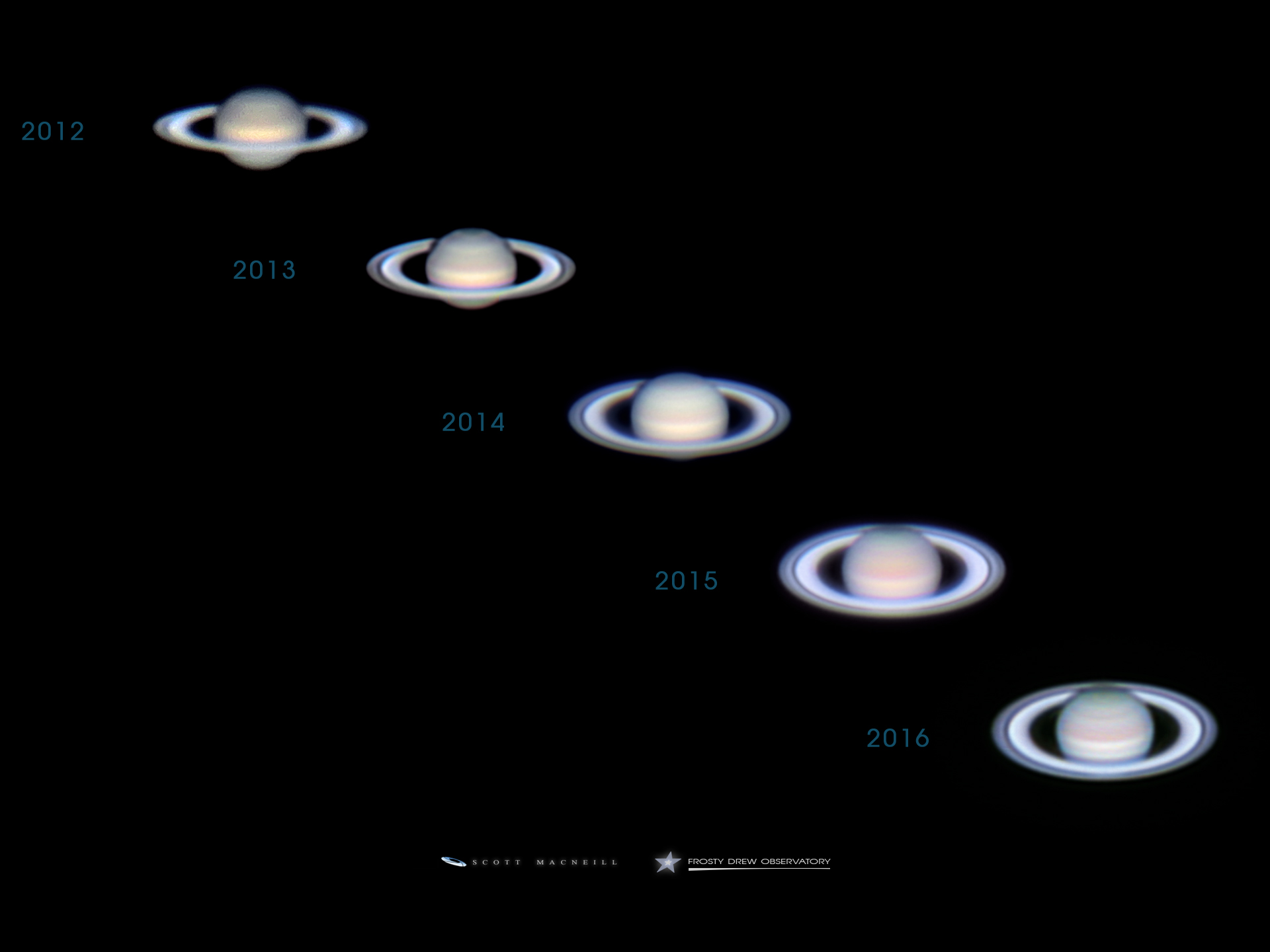
Summer is for Saturn
June 2017 :
Note: This article may contain outdated information
This article was published in the June 2017 issue of The Skyscraper and likely contains some information that was pertinent only for that month. It is being provided here for historical reference only.
Just about everyone’s favorite planet has been in the news lately. I’m talking about that beautiful ringed world Saturn. The Cassini spacecraft, launched in 1997, has been orbiting Saturn since 2004, making a multitude of passes of the planet and some of his moons. Thousands of detailed images have been taken, as well as a wide variety of scientific measurements.
However, the end is near for Cassini. On September 15 the craft will descend into Saturn’s cloud tops and disintegrate. This dramatic end to a very successful exploration of the Saturnian system was developed many years ago by NASA JPL mission planners. But wait. There’s more!
Beginning on April 26 the spacecraft made the first of a total of 22 passes through the 1500-mile gap between Saturn and his innermost known ring. It performed this maneuver at around 77,000 mph. Check out the video on this web site:
The spacecraft was oriented so its 13 foot in diameter antenna was pointed in the direction of motion, acting as a “deflector,” in anticipation of running into any dust particles along the trajectory. At Cassini’s speed colliding with even a small speck could compromise the integrity of the spacecraft. As luck would have it, not much dust was detected, prompting Project Manager Earl Maize of NASA’s JPL to say, "The region between the rings and Saturn is 'the big empty,' apparently."
Your exploration of Saturn can begin immediately. However, on June 15 this exquisite world will be at its closest distance to the Earth for 2017—still a distant 840,320,000 miles. When the Sun sets Saturn will be rising. This phenomenon is called an opposition, since the planet will be opposite the Sun in our sky. This event will herald a summer of Saturn observing.
Saturn can be found in the constellation of Ophiuchus, a rather obscure sky pattern between Scorpius and Sagittarius. Though Ophiuchus is actually a zodiacal constellation (which means the sun passes through it), it is not one of the twelve official zodiacal constellations. That’s a story for another column. Bright Saturn is to the left of the scorpion and to the right of the archer, sitting amongst the pale haze of stars that is our Milky Way Galaxy. This milky haze rises like steam from the “teapot” asterism of Sagittarius.
To observe as much detail as possible you should wait until Saturn, or any astronomical object, rises well enough above the horizon to minimize atmospheric turbulence. Depending upon your observing location you may also have to wait until later in the evening for Saturn to clear your local tree-line or neighbor’s house. If you don’t consider the latter, the police may pay you a visit.
When you first acquire Saturn with a telescope its rings will initially take your breath away. They are really an impressive sight to behold. The ring system is tilted 26-plus degrees toward the Earth providing us with a view of the north face of the ring plane. With the rings so “wide open,” this configuration allows much detail to be seen. You’ll understand what I mean as soon as you gaze at this splendid sight. The rings will continue to open until October when they will be at their maximum “openness” or tilt of about 27 degrees.
It is really amazing that Saturn’s rings are even visible at all, considering the planet’s great distance from the Earth and the fact that the main rings are only about 32 feet thick, with other portions of the ring system up to about two-thirds of a mile thick. The rings are composed of irregularly shaped dirty snowballs, ranging in size from grains of dust to the size of pebbles. There are also some “boulders” as large as several feet across. They all orbit Saturn along the planet’s equatorial plane. Look for gaps within the ring system.
Though Saturn is a gas giant a little smaller than Jupiter, it does not exhibit the prominent bands and zones in its cloud tops as its larger cousin does. Not much detail can be observed at all on Saturn’s disk. In fact, if it weren’t for Saturn’s ring system, this planet would be quite a boring destination for most amateur astronomers and the public alike.
A keen-eyed observer can look for the shadow of the rings upon Saturn’s cloud tops. The configuration of the rings provides a stunning 3-D effect of the Saturnian system. One can also detect up to eight of its brightest moons in a dark moonless sky with the telescopes available locally. So now through about mid-November treat yourself and your family and friends to wonderful views of Saturn. And while you do so, imagine you’re a stowaway aboard Cassini as it traverses that 1500 mile gap between Saturn and his rings. Your view from here on Earth won’t be as spectacular, but Saturn will still knock your socks off. You won’t be disappointed.

And finally, the Summer Solstice arrives at 12:24 a.m. EDT (Eastern Daylight Time) on June 21.
Spend some quality time this summer exploring the many astronomical pleasures provided by the local observatories throughout Rhode Island. Marvel at Saturn’s rings and moons from any of the following facilities. Seagrave Memorial Observatory in North Scituate is open every clear Saturday night. Ladd Observatory in Providence is open every clear Tuesday night. The Margaret M. Jacoby Observatory at the CCRI Knight Campus in Warwick is open every clear Wednesday night. Frosty Drew Observatory in Charlestown is open every clear Friday night. Check the respective websites for open times.
Keep your eyes to the skies.
Great American Total Solar Eclipse on August 21, 2017. Countdown: 82 days as of June 1, 2017.
Image is a composite compiled by Scott MacNeill, director of Frosty Drew Observatory in Charlestown. He imaged Saturn during successive oppositions(close approaches) from 2012 to 2016 to show the changing tilt of the rings.



